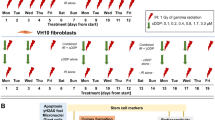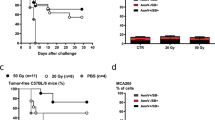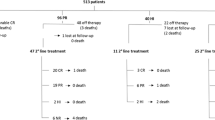Abstract
Resistance to cytotoxics precludes the successful treatment of many solid tumours. Inhibition of DNA synthesis in normal tissues with antimetabolites such as hydroxyurea (HU) may be a useful means of improving the selective uptake of toxic thymidine analogues by the relatively resistant tumour cells. HU also inhibits DNA repair by the critical depletion of intracellular deoxyribonucleotides. Twenty-five patients with various malignancies received 5-iodo-2-deoxyuridine (IUdR) 100 mg m-2 as a 20 min i.v. infusion and the uptake of IUdR was determined 1 h later immunocytochemically. Of these patients, 14 received IUdR 23 h from the start of a continuous i.v. infusion of HU (36 g over 36 h). Uptake of IUdR was equally suppressed in bone marrow and tumour aspirates, 0.1% (+/- 0.2%) of marrow precursor cells and 0.5% (+/- 0.4%) of tumour cells respectively, in patients who received HU compared to the uptake of IUdR in 11 patients who were not given HU 6.8% (+/- 1.1%) and 12.2% (+/- 1.8%) respectively. Mean HU plasma concentrations at the time of IUdR administration was 1.7 +/- 0.2 mM. The growth fraction of tumour cells (using Ki67 labelling) was not changed after treatment with HU. It is concluded that (1) since DNA synthesis is effectively inhibited by HU in tumour cells, differential uptake of radiolabelled IUdR by those cells will not be feasible using the current schedule of HU administration, (2) HU may be used as an inhibitor of DNA repair in vivo since the degree of inhibition correlates with that required to inhibit repair experimentally and that (3) Ki67 labelling index is not useful in studying cell kinetics in patients treated with HU.
This is a preview of subscription content, access via your institution
Access options
Subscribe to this journal
Receive 24 print issues and online access
$259.00 per year
only $10.79 per issue
Buy this article
- Purchase on Springer Link
- Instant access to full article PDF
Prices may be subject to local taxes which are calculated during checkout
Similar content being viewed by others
Author information
Authors and Affiliations
Rights and permissions
About this article
Cite this article
Philip, P., Kaklamanis, L., Carmichael, J. et al. The influence of high dose hydroxyurea on the incorporation of 5-iodo-2-deoxyuridine (IUdR) by human bone marrow and tumour cells in vivo. Br J Cancer 67, 644–649 (1993). https://doi.org/10.1038/bjc.1993.120
Issue Date:
DOI: https://doi.org/10.1038/bjc.1993.120



